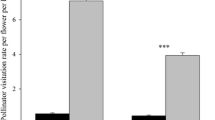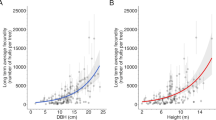Summary
Effects of supplemental hand pollination on fruit set, seed number, and seed weight were examined for 3 perennial, woodland herbs, Uvularia sessilifolia, Geranium maculatum, and Maianthemum canadense. We found no evidence for pollen limitation of any measure of fecundity. Low light probably limited fecundity in Geranium, while soil nitrogen limited the number of sseds/fruit in Maianthemum. For Geranium and Maianthemum the relationship between the number of flowers and fecundity varied in differeent years. Maianthemum ramets with greater than average flower numbers had a decreased chance of reproductive failure than did ramets with few flowers.
Similar content being viewed by others
References
Aker CL (1982) Regulation of flower, fruit and seed production by a monocarpic perennial, Yucca whipplei. J Ecol 70:357–372
Anderson RC, Beare MH (1983) Breeding system and pollination biology of Trientalis borealis (Primulaceae). Amer J Bot 70:408–415
Bell G (1985) On the function of flowers. Proc R Soc London B 224:223–265
Bertin RI (1982) Floral biology, hummingbird pollination and fruit production of trumpet creeper (Campsis radicans, Bignoniaceae). Amer J Bot 69(1):122–134
Bierzychudek P (1981) Pollinator limitation of plant reproductive effort. Amer Nat 117:838–840
Bierzychudek P (1982a) The demography of jack-in-the-pulpit, a forest perennial that changes sex. Ecol Monogr 52:335–351
Bierzychudek P (1982b) Life histories and demography of shadetolerant temperate forest herbs: a review. New Phytol 90:757–776
Casper BB (1983) The efficiency of pollen transfer and rates of embryo initiation in Cryptantha (Boraginaceae). Oecologia (Berlin) 59:262–268
Hainsworth FR, Wolf LL, Mercier T (1985) Pollen limitation in a monocarpic species, Ipomopsis aggregata. J Ecol 73:263–270
Heinrich B (1979) Bumblebee economics. Harvard University Press, Cambridge Massachusetts, USA
Hill-Cottingham DG, Williams RR (1967) Effect of time of application of fertilizer nitrogen on the growth, flower development, and fruit set of maiden apple trees, var. Lord Lambourne, and on the distribution of total nitrogen within the trees. J Hort Sci 42:319–338
Lee TD, Bazzaz FA (1982) Regulation of fruit and seed production in an annual legume. Cassia fasciculata. Ecology 63:1363–1373
Lubbers AE, Christensen NL (1986) Intraseasonal variation in seed production among flowers and plants of Thalictrum thalictroides (Ranunculaceae). Amer J Bot 73:190–203
Martin M (1965) An ecological life history of Geranium maculatum. Amer Midl Nat 73:111–149
McCall C, Primack RB (1985) Effects of pollen and nitrogen availability on reproduction in a woodland herb, Lysimachia quadrifolia. Oecologia (Berlin) 67:403–410
Melampy MN, Hayworth AM (1980) Seed production and pollen vectors in several nectarless plants. Evolution 34:1144–1154
Motten AF (1983) Reproduction of Erythronium umbilicatum (Liliaceae): Pollination success and pollinator effectiveness. Oecologia (Berlin) 59:351–359
Motten AF (1986) Pollination ecology of the spring wildflower community of a temperate deciduous forest. Ecol Monogr 56:21–42
Motten AF, Campbell DR, Alexander DE, Miller HL (1981) Pollination effectiveness of specialist and generalist visitors to a North Carolina population of Claytonia virginica. Ecology 62:1278–1287
National Oceanic and Atmospheric Administration (1982) Climatological data New England: Boston, Massachusetts. National Environmental Satellite, Data, and Information Service, Asheville, North Carolina, USA
National Oceanic and Atmospheric Administration (1983) Climatological data New England: Boston, Massachusetts. National Environmental Satellite, Data, and Information Service, Asheville, North Carolina, USA
Schaal BA (1980) Reproductive capacity and seed size in Lupinus texensis. Amer J Bot 67:703–709
Schemske DW (1977) Flowering phenology and seed set in Claytonia virginica (Portulacaceae). Bull Torrey Bot Club 104:254–263
Schemske DW (1980) Evolution of floral display in the orchid Brassavola nodosa. Evolution 34:489–493
Schemske DW, Willson MF, Melampy MN, Miller LJ, Verner L, Schemske KM, Best LB (1978) Flowering ecology of some spring woodland herbs. Ecology 59:351–366
Silva JF (1978) Studies on the population biology of Maianthemum canadense Desf. Dissertation. Harvard University, Cambridge, Massachusetts, USA
Sokal RR, Rohlf FJ (1981) Biometry. Freeman, San Francisco
Stephenson AG (1979) An evolutionary examination of the floral display of Catalpa speciosa (Bignoniaceae). Evolution 33:1200–1209
Sutherland S, Delph LF (1984) On the importance of male fitness in plants: patterns of fruit set. Ecology 65:1093–1104
Swanson SD, Sohmer SH (1976) The biology of Podophyllum peltatum L. (Berberidaceae), the may apple. II. The transfer of pollen and success of sexual reproduction. Bull Torrey Bot Club 103:223–226
Van Andel J, Vera F (1977) Reproductive allocation in Senecio sylvaticus and Chamaenerion angustifolium in relation to mineral nutrition. J Ecol 65:747–758
Waller DM (1982) Factors influencing seed weight in Impatiens capensis (Balsaminaceae). Amer J Bot 69:1470–1475
Weis IM (1982) The effects of propagule size on germination and seedling growth in Mirabilis hirsuta. Can J Bot 60:1868–1874
Whigham D (1984) The effect of competition and nutrient availability on the growth and reproduction of Ipomoea hederacea in an abandoned old field. J Ecol 72:721–730
Willson MF, Price PW (1977) The evolution of inflorescence size in Asclepias (Asclepiadaceae). Evolution 31:495–511
Willson MF, Price PW (1980) Resource limitation of fruit and seed production in some Asclepias species. Can J Bot 58:2229–2233
Willson MF, Schemske DW (1980) Pollinator limitation, fruit production and floral display in pawpaw (Asimina triloba). Bull Torrey Bot Club 107:401–408
Willson MF, Miller LJ, Rathcke BJ (1979) Floral display in Phlox and Geranium: Adaptive aspects. Evolution 33:52–63
Author information
Authors and Affiliations
Rights and permissions
About this article
Cite this article
McCall, C., Primack, R.B. Resources limit the fecundity of three woodland herbs. Oecologia 71, 431–435 (1987). https://doi.org/10.1007/BF00378717
Received:
Issue Date:
DOI: https://doi.org/10.1007/BF00378717




